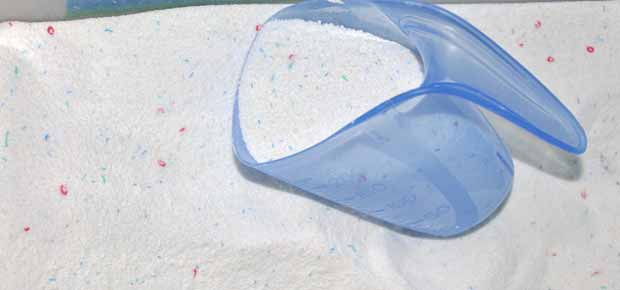Detergent builders are materials, which can be used to bind cations (mainly calcium, Ca2+, and magnesium Mg2+) contained in wash solutions that results in water softening. Builders enhance the quality of the water, thereby making the detergents work in a more effective and efficient manner.
Detergent builders soften water by holding free water ions, such as magnesium and calcium. This prevents these particles to react with other ingredients of detergent, which would have caused them to work less efficiently or precipitate from solution (soap scum). They can produce insoluble salts, which become beset in the clothes and deposit on solid surfaces inside the washing machine. In this manner, builders also help in extending the life of the washing machine. Soil molecules are sometimes bound to the clothes surface by calcium ion bridging, removal of hardness from the environment and therefore help in removal of stains. Sometimes more than one detergent builder is used in a product, to develop a builder system with more effective cleaning performance.
Types
On the basis of characteristics and properties, detergent builders can be
categorized into two types

Detergents, as we know, consist of surfactants and chelating agents. Surfactants remove and clean dirt from a soiled surface, while chelating agents are used to surround unwanted metal ions that are found in cleaning solutions. Though very effective, chelating process is expensive and is not always necessary and in cases such as these, builders have found to be a good alternative. Builders improve the detergency action, and being relatively cheap, less can be used of the more expensive detergents of superior activity.
Traditionally, sodium tripolyphosphate (STPP) was the builder of choice. It offers superior water softening because of its high binding capacity for heavy metals and calcium ions, good buffering properties that contribute to detergency action and superior anti-redeposition properties. In addition, the position of STPP as a preferred builder during 1940s-1970s was further boosted because of its low toxicity. Although STPP has low toxicity, as a nutrient, it has the potential result in eutrophication (a term used to describe water that is 'over rich' in nutrients, and may to an excessive growth of algae). This led to the search for alternative products and the development of synthetic detergent Zeolite, which now days, is the principle alternative to phosphate builders.
Properties
Builders are basically water softeners that are used to soften wash water
by extracting and binding the magnesium and calcium ions. Due to the action
of builder, the availability of these ions is removed from the wash-water
solution, and as result the hardness of wash-water is removed. Depending on
the type of builder, other benefits may be available, such as -
Advantages
The prime function of detergent builders is to upgrade and prevent the
cleaning efficiency of surfactants. Builders offer a number of advantages,
including softening, buffering, and emulsifying. Some of the important
advantages of using a builder in a wash solution are -

If you have decided to make soap at home, you will need soap making supplies in the form of raw materials, soap making equipment & tools ...
Read More
Someone has rightly said that clothes are not just clothes. They form an integral part of a person's personality and tell a lot about their nature and...
Read MoreCleansing products play an important role in the daily lives of people.
Both soaps and detergents are cleansing products that we frequently use in our
Soap is designed as a product to be used once and then flushed down the drain...